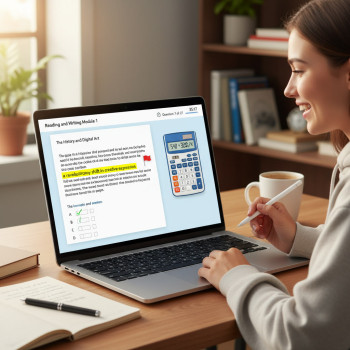Why a Weekly SAT Self-Review Session Works
If preparing for the Digital SAT sometimes feels like trying to drink from a firehose, the weekly self-review session is your slow, steady sip. Rather than marathon cramming or randomly doing practice problems, a focused weekly review creates a rhythm: practice, reflect, and improve. Over weeks and months this rhythm compounds into real score gains and calmer test-day nerves.
This post gives you a friendly, practical blueprint for running a weekly SAT self-review session that fits into a busy school week, keeps motivation up, and points you to where personalized help—like Sparkl’s one-on-one tutoring and tailored study plans—can amplify your efforts when you need it.
How to Structure a 60–90 Minute Weekly Review Session
Think of the session as four clear parts: quick warm-up, focused practice, targeted review, and planning. That balance keeps you in the zone, helps your brain consolidate learning, and makes the next week more productive.
Part 1 — 10 minutes: Quick Warm-Up and Check-In
- Skim your weekly goals: Did you hit them? If not, why?
- Do a 5–8 minute warm-up: a mix of two short Reading passages or 6–8 Math practice items to get your brain firing on the right circuits.
- Log anything unusual: stress, lack of sleep, or time constraints — these influence results and future planning.
Part 2 — 25–40 minutes: Focused Practice
Pick one tight target for the week: algebraic manipulatives, data interpretation, command of evidence, or passage vocab-in-context. Practice with a short block of problems (15–25 minutes) under realistic timing, then do a quick correction pass. Quality beats quantity here.
Part 3 — 20–30 minutes: Deep Review
This is the heart of the session. Don’t just mark answers right or wrong—explore why each answer is what it is. For each incorrect or guessed question, do the following in your notebook:
- Write the question type and the underlying skill (e.g., Linear equations, Supporting detail, Function interpretation).
- Note the exact mistake: conceptual gap, careless error, misread, or timing issue.
- Create a 1–2 sentence correction strategy you can use next time.
Part 4 — 5–10 minutes: Plan Next Week
End by scheduling specific, tiny tasks for next week. Where do you need to spend extra time? What problems or passage types will you target? These micro-goals increase the odds that the next session starts strong.
Before Your First Weekly Session: What to Prepare
Gather these items once and keep them handy each week:
- One short official practice set or 20–30 minutes of mixed practice (Digital SAT-style if possible).
- A notebook or digital document labeled “Weekly SAT Review” with dated entries.
- Timer or phone (use only for timing, not distractions!).
- Answer explanations for the practice set you used (official College Board explanations or trusted materials).
- A short score-tracking table to monitor trends across weeks.
Sample Weekly Review Template (Fill This Out Every Session)
Use this mini-template in your notebook at the start of every session to create a consistent habit:
- Date:
- Time spent:
- Focus skill(s):
- Practice source / section:
- Top 3 mistakes and short fixes:
- Micro-goal for next week:
Table: Example 6-Week Review Log
This table shows how a student might record progress and adjust plans. It’s compact so you can replicate it in a spreadsheet or your notebook.
| Week | Focus | Practice (mins) | Avg Accuracy | Top Mistakes | Next Week’s Micro-Goal |
|---|---|---|---|---|---|
| 1 | Algebra: linear equations | 60 | 68% | Sign errors, misreading negatives | Daily 10-min equation drills |
| 2 | Reading: Command of Evidence | 75 | 72% | Skipping lines of evidence | Annotate 2 passages this week |
| 3 | Math: systems of equations | 60 | 70% | Choosing inefficient methods | Practice substitution/elimination |
| 4 | Math: data & graphs | 50 | 75% | Rushing charts, misread scales | Slow, labeled reads of 5 graphs |
| 5 | Reading: inference & tone | 80 | 78% | Overstating evidence | Underline tone words; justify |
| 6 | Full mixed set review | 90 | 81% | Timing on last passage | Practice timed final passage weekly |
How to Review Different Question Types
Each question type benefits from a slightly different review approach. Rotate through these during your weekly sessions so every skill grows.
Reading: Passage-Based Questions
- Read the question before rereading the passage for targeted scanning.
- Underline or mark lines of evidence; write one-sentence paraphrases for hard paragraphs.
- When you miss a question, cite the sentence in the passage that disproves your incorrect answer.
Writing & Language
- Spot the role: Is this sentence about clarity, concision, grammar, or expression?
- Practice rewriting one confusing sentence per week to build style instincts.
- When you miss, note whether it was grammar knowledge or language usage—these need different follow-ups.
Math (No Calculator & Calculator Sections)
- Work out problems fully at least once during review so you can see where mistakes cropped up.
- For algebra and functions, practice writing the steps cleanly—this reduces careless errors.
- For data and geometry, sketch quick diagrams and label everything: that small habit saves time and mistakes.
Diagnosing Mistakes: The Most Valuable 10 Minutes
Spend ten minutes after each practice block tagging each error as one of the following: Conceptual, Careless, Timing, or Strategy. Keep a rolling list of the most common mistake types; these tell you exactly what to target in future micro-goals.
Here’s a quick checklist you can use:
- Conceptual (I don’t understand the math rule or reading tactic).
- Careless (I misread a sign, skipped a word, or mis-copied).
- Timing (I ran out of time or rushed near the end).
- Strategy (I picked an inefficient method; guessed too early).
Weekly Mini-Drills and Daily Habits That Stick
The weekly session is powerful, but coupling it with short daily habits accelerates progress. Choose two tiny, repeatable tasks:
- Daily 10-minute problem set (3–5 Math items or one 10-minute Reading passage).
- One short grammar rewrite or vocab-in-context mini-exercise (5 minutes).
- End-of-day 2-minute reflection: what worked and one specific adjustment for tomorrow.
How to Use Practice Tests with Weekly Reviews
Full practice tests are coaching tools, not weekly rituals. Take a full, official practice test every 3–4 weeks early in prep, and every 1–2 weeks as your test date nears. After each full test, substitute your normal weekly session with an in-depth test review—this helps you translate practice-test experience into consistent improvements.
When To Call for Extra Help: Where Sparkl’s Personalized Tutoring Fits In
Weekly self-review sessions are great for building independent skills, but sometimes you’ll hit a persistent roadblock: a concept that keeps producing incorrect answers, or you can’t shave enough time off a section. That’s a natural moment to bring in personalized support. Sparkl’s personalized tutoring can offer:
- 1-on-1 guidance to clarify stubborn concepts quickly.
- Tailored study plans that slot into your weekly review rhythm.
- Expert tutors who model efficient strategies and help you practice them until they stick.
- AI-driven insights that highlight error patterns and recommend the most effective drills.
Think of a tutor as a targeted boost: you still do the weekly work, but the tutor helps you do it smarter and faster. Use weekly reviews to identify the exact things to bring to a tutoring session, and you’ll get much more from each one-on-one meeting.
Make It Sustainable: Motivation, Accountability, and Small Wins
Consistency beats intensity. It’s better to do a 60–90 minute review session every week for months than to cram for days and then lose momentum. Here are a few ways to stay on track:
- Celebrate small wins: a single question type improved, a timing goal reached, or a three-week streak of consistent review.
- Buddy up: swap weekly summaries with a friend or study partner for accountability (no score-sharing necessary—just progress notes).
- Use your review notebook as a progress diary—flipping through it after six weeks is surprisingly motivating.
Sample 8-Week Plan: How Weekly Reviews Fit Into a Timeline
Below is a sample outline to show how weekly sessions can build on one another. Adjust the detail and pacing to your test date and baseline score.
- Weeks 1–2: Baseline practice and major-skill triage (identify weakest areas).
- Weeks 3–4: Focused remediation on top two weaknesses; add daily mini-drills.
- Weeks 5–6: Bring in mixed practice and timing drills; consider one or two tutoring sessions to unblock persistent gaps.
- Weeks 7–8: Full-length practice test, intensive review, and final polishing of timing strategies.
Example Review Notes — A Realistic Walkthrough
Here’s what a completed session entry might look like in your notebook after a focused 75-minute review:
- Date: April 12
- Time: 75 minutes
- Warm-up: 2 Reading passages, 8 Math items (8/10 correct)
- Focused practice: 20 minutes — 10 algebra problems (6 correct); common error: sign reversal
- Deep review: Reworked 4 missed problems; wrote short rules (e.g., “when isolating x, always add opposite to both sides”)
- Micro-goal: 5-minute algebra equation set each weekday; ask tutor to demonstrate two solving shortcuts
Timing Tips: How to Shrink the Clock Without Panic
Practice timing in small ways: set a timer for one passage, not the whole section; practice the last 10 minutes of a section to train your finish. In your weekly review, include a short timing drill so speed becomes a habit rather than a last-minute scramble.
When timing gets tight, go back to your error tags. Are you losing points to careless errors? Slow down a little. Are you losing points to conceptual gaps? Stop guessing and build the targeted micro-practice plan.
Common Pitfalls and How to Avoid Them
- Pitfall: Skipping review and only doing new problems. Fix: Always review mistakes and spend at least 20 minutes per session on correction.
- Pitfall: Vague goals. Fix: Use micro-goals (e.g., “three substitution problems daily”) instead of “study math.”
- Pitfall: Treating practice tests like performances only. Fix: After each test, spend double the test time reviewing the problems you missed.
How to Adapt If You Only Have 30 Minutes a Week
If life is hectic and you can spare only 30 minutes, focus on these highest-value activities:
- 10 minutes: targeted warm-up (one passage or 5 math problems).
- 10 minutes: deep review of one or two missed items—don’t just mark them wrong.
- 10 minutes: schedule a precise micro-goal for the week.
Even a short, disciplined session like this, repeated weekly, moves the needle over months.
Measuring Progress: What To Track
Quantitative measures matter, but so do qualitative ones. Track both:
- Quantitative: weekly accuracy percentage by section, timed passage speed, and official practice test score every few weeks.
- Qualitative: confidence with question types, whether you feel calmer under time pressure, and whether the same mistakes keep recurring.
Final Thoughts: Keep It Human, Keep It Flexible
A weekly SAT self-review session is more than a checklist—it’s a conversation between you and your future test-taking self. Be curious about your mistakes. Be patient with slow weeks. And be honest when you need help: targeted, personalized tutoring (for example, Sparkl’s one-on-one sessions and AI-driven insights) can turn weeks of small practice into real breakthroughs.
Make the review routine yours. Tweak the timing, pick the skills that matter to you most, and celebrate the small wins. Over time, your weekly sessions will not only sharpen your SAT skills but also build a study habit and confidence that lasts far beyond one test day.
Quick Checklist to Start Your Weekly Session Tonight
- Set a 60–90 minute block and remove distractions.
- Choose one practice source and your weekly focus skill.
- Do the warm-up, focused practice, deep review, and plan next steps.
- Log one micro-goal and one metric to track over the next week.
- If you’re stuck on the same concept after two sessions, schedule a targeted tutoring session to unblock progress.
One Last Note
This routine is intentionally simple because simplicity is what students actually sustain. The power comes from repetition, honest review, and smart adjustments. Use your weekly sessions to build momentum, and when you need an expert nudge, consider personalized support—like Sparkl’s tailored plans and expert tutors—to translate hard work into high scores. You’ve got this.













No Comments
Leave a comment Cancel